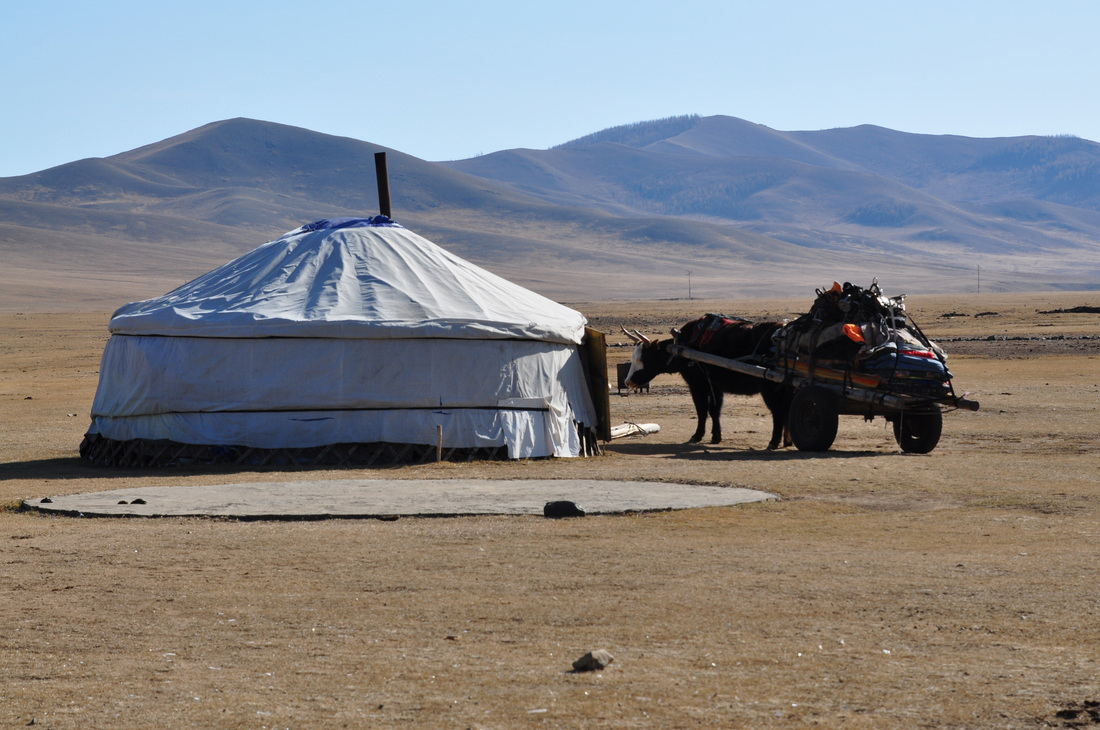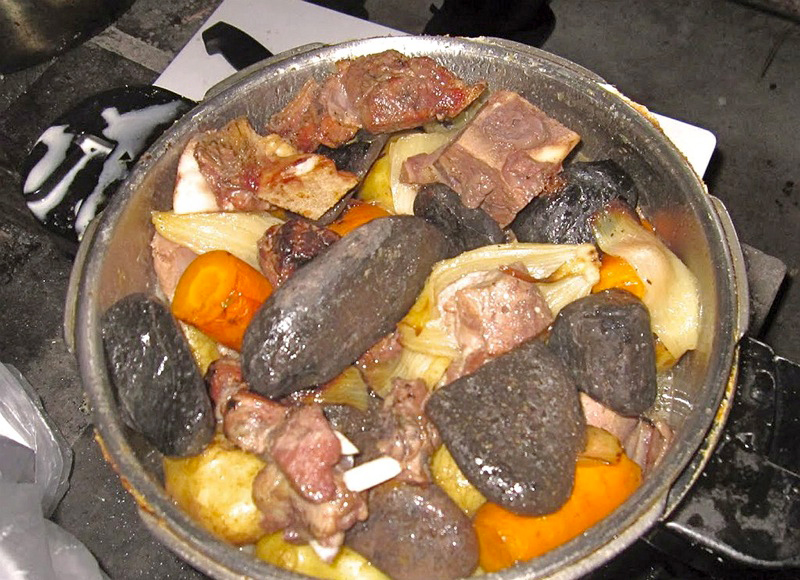
The culture and society of Mongolia is greatly influenced by the central role of nomadic lifestyle which is still the way of life for half of Mongolia's population of 2.9 million people. Mongolia is one of the last nations in the world today that has such a high proportion of nomadic citizens.
Mongolian music conveys this deep appreciation that Mongolians have for their country, its natural beauty and the inspiring deep blue sky above the vast Mongolian landscape. Mongolian songs are often about beloved horses and the beauty of the Mongolian countryside. Herders sing while riding their horses and most Mongolians are expected to know at least one song to be shared with others on special occasions or just to lighten the heart.
Khoomi Singing which also known as Throat Singing, allows the singer to produce harmonic tones that can mirror the sounds of waterfalls, the steppe winds blowing, and the chants of Buddhist monks. Khoomi singers use their diaphragms like a bellows on a bagpipe to emit a steady bass note while simultaneously producing a higher nasal tone and essentially carrying two tunes at the same time. Click in to watch Mongolian Khoomii singing-
The traditional Long Song is the great Mongolian classical form of singing and is a powerful way of musically expressing deep emotions for loved ones, the land, nature and beloved horses. Of all the Mongolian musical instruments the Morin Khuur (Horse Head Fiddle) has the most prominent place in Mongolian musical forms. Legend has it that a long time ago when the beloved horse of a young Mongolian died, he made a musical instrument from its hair and hide to remind him of his dear friend. The Morin Khuur can produce the rich varied tones of a cello or be coaxed to sound like a horse neighing and galloping. Click in to watch Mongolian Long Song-
Click in to watch Mongolian Morin Khuur-
Traditional Mongolian wrestling called Bukh is the most prominent sport amongst Mongols and is one of the three arenas of completion in the greatest of the annual Mongolian national celebrations called the Naadam. Archery and horseracing are the two other competition sports in the Naadam but the champion wrestlers win the greatest glory. Mongolians prize the strength, skill and dignified character that are the hallmark of great wrestler champions.
Mongolians hospitality is legendary and is a very important part of Mongolian society and culture. Anyone are welcomed in the round nomadic home call Gers to share cheese, yogurt, and Airag which is fermented mares milk and cherished also by Mongolian city dwellers.
ABOUT GER-TRADITIONAL DWELLING
 Over the centuries, nomads have principally depended on this collapsible, round tent. Its durability, lightness and low cost are of tremendous advantage to the nomad. The Ger is more than a tent, it is a "home", since Mongols live in it throughout the year and prefer them to other forms of housing. The Ger is a unique model of engineering - an ingenious prefabricated home. It is mostly made of wood and other locally available materials. Quickly assembled or taken to pieces, it is easily transported on camelback or by truck. The lower part of the Ger consists of sections of trellis-like walls of willow wood, including the door within its circular frame work. The upper part consists of two long upright poles supporting a central wooden roof ring, (toono), onto which many thinner poles are placed. Depending on the size of the Ger, roof poles can number up to 108 (a sacred Buddhist number). Each one fits onto the lattice walls, fixed by straps of raw hide made from camel skin. The roof ring is the most complex part of the structure. Apart from holding the poles in place and acting as a smoke vent, it is also a natural sundial. The early-morning rays indicate time for milking and pasturing animals. If it shines to the back of the Ger, it is after midday and "too late" to set out on a long journey. During bad weather, the single roof ring "window" is covered with a piece of felt, or hide, called an urkh.
Over the centuries, nomads have principally depended on this collapsible, round tent. Its durability, lightness and low cost are of tremendous advantage to the nomad. The Ger is more than a tent, it is a "home", since Mongols live in it throughout the year and prefer them to other forms of housing. The Ger is a unique model of engineering - an ingenious prefabricated home. It is mostly made of wood and other locally available materials. Quickly assembled or taken to pieces, it is easily transported on camelback or by truck. The lower part of the Ger consists of sections of trellis-like walls of willow wood, including the door within its circular frame work. The upper part consists of two long upright poles supporting a central wooden roof ring, (toono), onto which many thinner poles are placed. Depending on the size of the Ger, roof poles can number up to 108 (a sacred Buddhist number). Each one fits onto the lattice walls, fixed by straps of raw hide made from camel skin. The roof ring is the most complex part of the structure. Apart from holding the poles in place and acting as a smoke vent, it is also a natural sundial. The early-morning rays indicate time for milking and pasturing animals. If it shines to the back of the Ger, it is after midday and "too late" to set out on a long journey. During bad weather, the single roof ring "window" is covered with a piece of felt, or hide, called an urkh.
The outside wall is wrapped with felt pieces placed across the top of the Ger, leaving the roof ring open for the stove's chimney, light and air. Canvas (for waterproofing) covers the Ger and is tied around the outer wall by three rows of rope made from horses' hair. In winter, extra felt is added. In summer the wall felt can be rolled up from ground level to let in the breeze. The Ger is pitched on the ground, and the floor area is covered by carpets, unless the Ger will stay in place for some time, in which case a wooden floor is laid.
TRADITIONAL CLOTHING
The Deel is the Mongolian traditional clothes, worn on both workdays and special days. It is a long, loose gown cut in one piece with the sleeves; it has a high collar and widely overlaps at the front. The deel is girdled with a sash. Each ethnic group living in Mongolia has its own deel distinguished by cut, color and trimming. The distinctions go unnoticed by foreigners, yet for the Mongolians they are obvious. Today, city people tend to wear European-style clothes. In the countryside, however, the modern attire is inconvenient and impractical. In the cities, as people start aging, especially the women, begin to appreciate the advantages of the deel and wear it, trying to excel each other in the choice of fabric, as well as in the elegance of the cut and originality of the trimmings. Commonly there are three varieties of deel, each for a particular season. The first, the dan deel, is very much like a dress, a frock cut in one piece from plain cloth without padding. Rural women wear dan deels all year around. In cold weather they put on warm clothes over them. Terleg is a slightly padded deel. And finally the winter deel is padded with sheepskin or cotton wool.
Deels for men and women are of the same cut. The difference is that male deels are wider and of more demure colors. The deel for everyday wear is grey, brown or some other dark color, while the holiday deel is a bright blue, green or claret silk with a silk sash of contrasting color several meters long. The sash is not simply an adornment. It also serves as a soft corset facilitating long rides on horseback. In days gone by, men would attach a sheathed knife, a tobacco pouch, a flint and a pipe-cleaning hook to the belt.. The deel collar, breasts and sleeves are trimmed with leather and color brocade tape, which can be wide or narrow depending on the wearer's taste. The deel buttons, if they are not commercially produced from decorative stones or silver, are narrow strips of cloth tied into intricate knots.
Traditional deels are normally seen now only at concerts or official occasions. In addition to the deel is the jacket known as a khurim. In cold weather it is put on over the deel. The Gutal is the high boot made from unbending leather and lined with fine and thin felt. They are decorated with different designs. Both the left and right are traditionally the same shape and were worn with thick socks made from quilted cloth. Traditional boots are without heels and have turned up toes. Mongolian Hats are still very much the normal attire in the countryside. The traditional hat is a hat for all seasons trimmed with fur, fox fur in most cases. The sides of the hat can be tied down to keep the ears warm or tied on top in the warmer periods. The hats are worn by both men and by women.
Because of the different ethnic groups residing in Mongolia, there are distinctions in the way they all dress. Therefore it is estimated that between them all, there are about 400 different types of deels, 20 boots, 10 sashes and 20 types of hats.
FOOD TRADITION
 Approximately twenty five million head of livestock supply the staples of the diet; meat and dairy products feature prominently in this cuisine. Mongolian cooking is generally very simple and does not use many spices, flavorings or sauces. Common dishes include steamed meat–filled dumplings ( buuz ), mutton soup with noodles ( guriltai shul ) and fried meat pasties ( huushuur ). One of the most tasty and exciting dishes in Mongolia is Khorkhog. Khorkhog is made by cooking pieces of meat inside a container which also contains hot stones and water, and is also heated from the outside. Mongolians drink copious quantities of milk tea (suutei tsai ), which frequently contains salt and a generous spoonful of fresh or rancid butt er.. Food is an important element of the Mongolian hospitality tradition. When guests arrive, each household sets out a special hospitality bowl containing homemade cheeses, flour pastries ( boortsog ), sugar cubes and candy. Meat filled dumplings are traditionally served to guests. Vodka shots are served at regular intervals during ceremonies.
Approximately twenty five million head of livestock supply the staples of the diet; meat and dairy products feature prominently in this cuisine. Mongolian cooking is generally very simple and does not use many spices, flavorings or sauces. Common dishes include steamed meat–filled dumplings ( buuz ), mutton soup with noodles ( guriltai shul ) and fried meat pasties ( huushuur ). One of the most tasty and exciting dishes in Mongolia is Khorkhog. Khorkhog is made by cooking pieces of meat inside a container which also contains hot stones and water, and is also heated from the outside. Mongolians drink copious quantities of milk tea (suutei tsai ), which frequently contains salt and a generous spoonful of fresh or rancid butt er.. Food is an important element of the Mongolian hospitality tradition. When guests arrive, each household sets out a special hospitality bowl containing homemade cheeses, flour pastries ( boortsog ), sugar cubes and candy. Meat filled dumplings are traditionally served to guests. Vodka shots are served at regular intervals during ceremonies.





